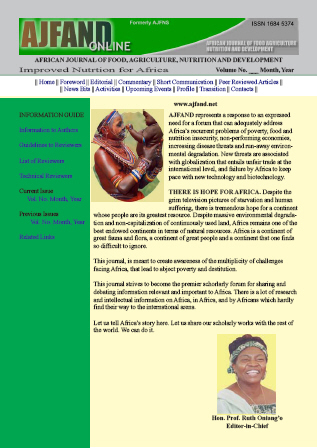
|
African Journal of Food, Agriculture, Nutrition and Development
Rural Outreach Program
ISSN: 1684-5358
EISSN: 1684-5358
Vol. 13, No. 5, 2013, pp. 8167-8186
|
 Bioline Code: nd13078
Bioline Code: nd13078
Full paper language: English
Document type: Research Article
Document available free of charge
|
|
|
African Journal of Food, Agriculture, Nutrition and Development, Vol. 13, No. 5, 2013, pp. 8167-8186
| en |
EVALUATION OF FISH HANDLING TECHNIQUES EMPLOYED BY ARTISANAL FISHERS ON QUALITY OF LETHRINIDS AND SIGANIDS FISH GENERA AT LANDING TIME ALONG THE KENYAN COAST USING SENSORY AND MICROBIOLOGICAL METHODS
Odoli, Cyprian Ogombe; Oduor-Odote, P. M.; Ohowa, B. & Onyango, S. O.
Abstract
In artisanal fishery, traditional handling methods such as tossing fish onto the boat
bottom or into woven mat baskets and gunny bags after capture are commonly
employed. These practices accelerate fish spoilage due to cross contamination and
exposure to high ambient temperature. This study aimed at investigating the effect of
non-icing (onboard handling methods) on the quality of Lethrinids (Emperor fish,
local name: Changu) and Siganids (Rabbitfish, local name: Tafi) landed along the
Kenyan coast in comparison to iced fish. Monthly, samples were assessed by sensory
methods using Quality Index Method (QIM), Total Viable Counts (TVC) and
hydrogen sulphide (H2S) producing bacteria considered as specific spoilage
organisms (SSO) counts for raw fish; Quantitative Descriptive Analysis (QDA) and
Torry score for cooked fillets. Iced fish was characterised by better freshness quality
attributes at landing time compared to non-iced at both landing sites. According to the
QIM, iced treatment recorded better quality scores that were significantly different
from non-iced groups (p<0.05) throughout the study with regard to fish genera.
Cooked fillets showed both treatments to be within human consumption limits
although non-iced fish were characterised by marginal quality attributes. Microbial
assessment depicted TVC to be on average 102- 103 CFU/g and 103- 104 CFU/g in
iced and non-iced Lethrinids respectively at both sampling sites. In Siganids higher
numbers of 104- 105 CFU/g were recorded in non–iced group, with H2S producing
bacteria constituting a higher proportion of TVC. Iced Siganids recorded 102- 103
CFU/g throughout the study. Fish quality was reported to be inconsistent over the
sampled month which reflects the large pressure systems of the Western Indian Ocean
and the two distinct monsoon periods considered to differ in warmth. The major cause
of deteriorated fish quality observed at landing time in the fishery was attributed to
bacterial proliferation accelerated most importantly by non-icing onboard handling
practises reported such as tossing fish onto the boat bottom or into woven mat baskets
and gunny bags employed by the fishers. Sensory evaluation of cooked fillets and
microbiological analysis showed fish was acceptable for human consumption
regardless of handling method employed. This assures consumers of acceptable fish
quality at landing time as long as good hygienic practices are observed at subsequent
stages to consumption.
Keywords
Lethrinids; Siganids; Quality; Sensory; Handling
|
| |
© Copyright 2013 - African Journal of Food, Agriculture, Nutrition and Development
Alternative site location: http://www.ajfand.net/
|
|
